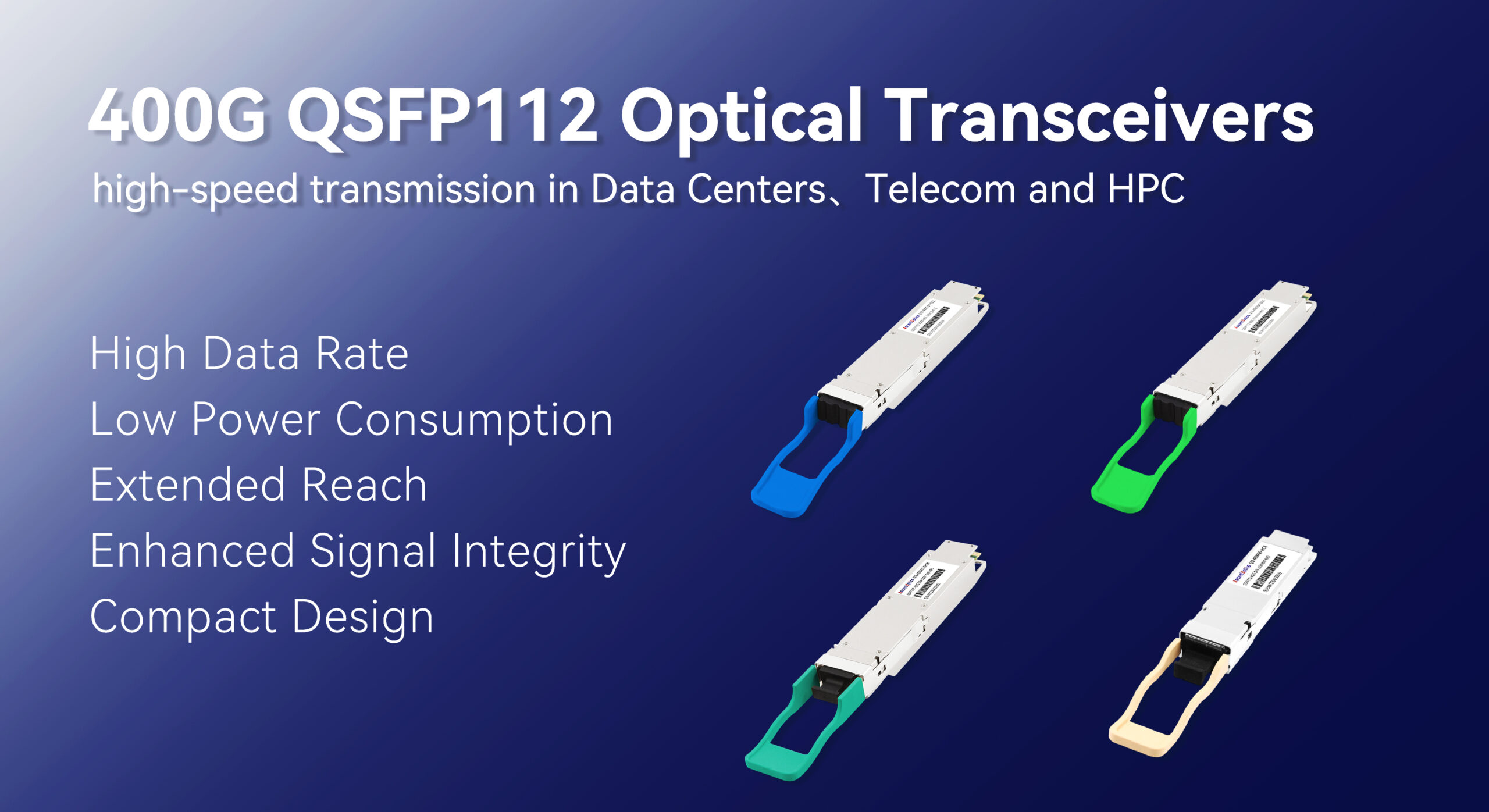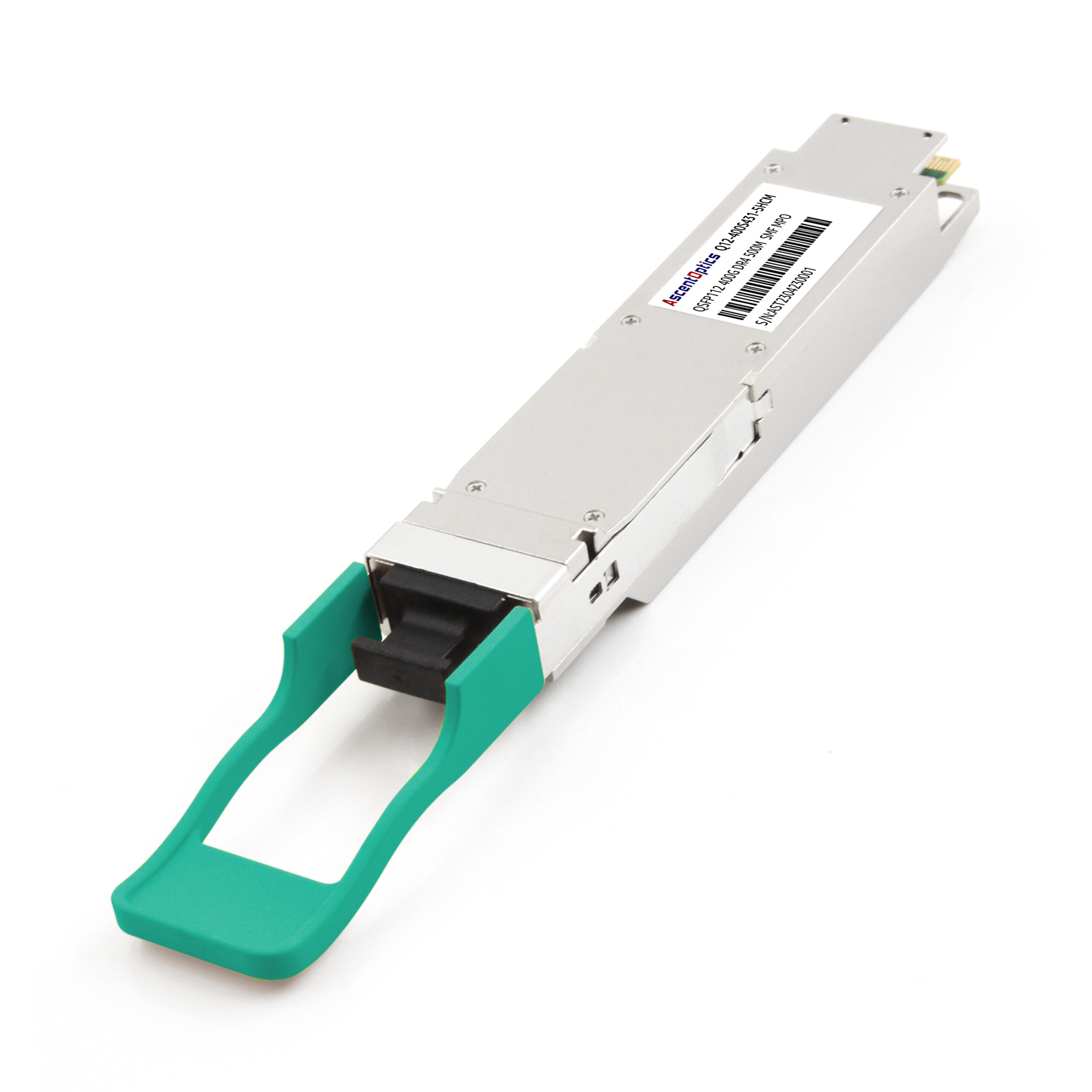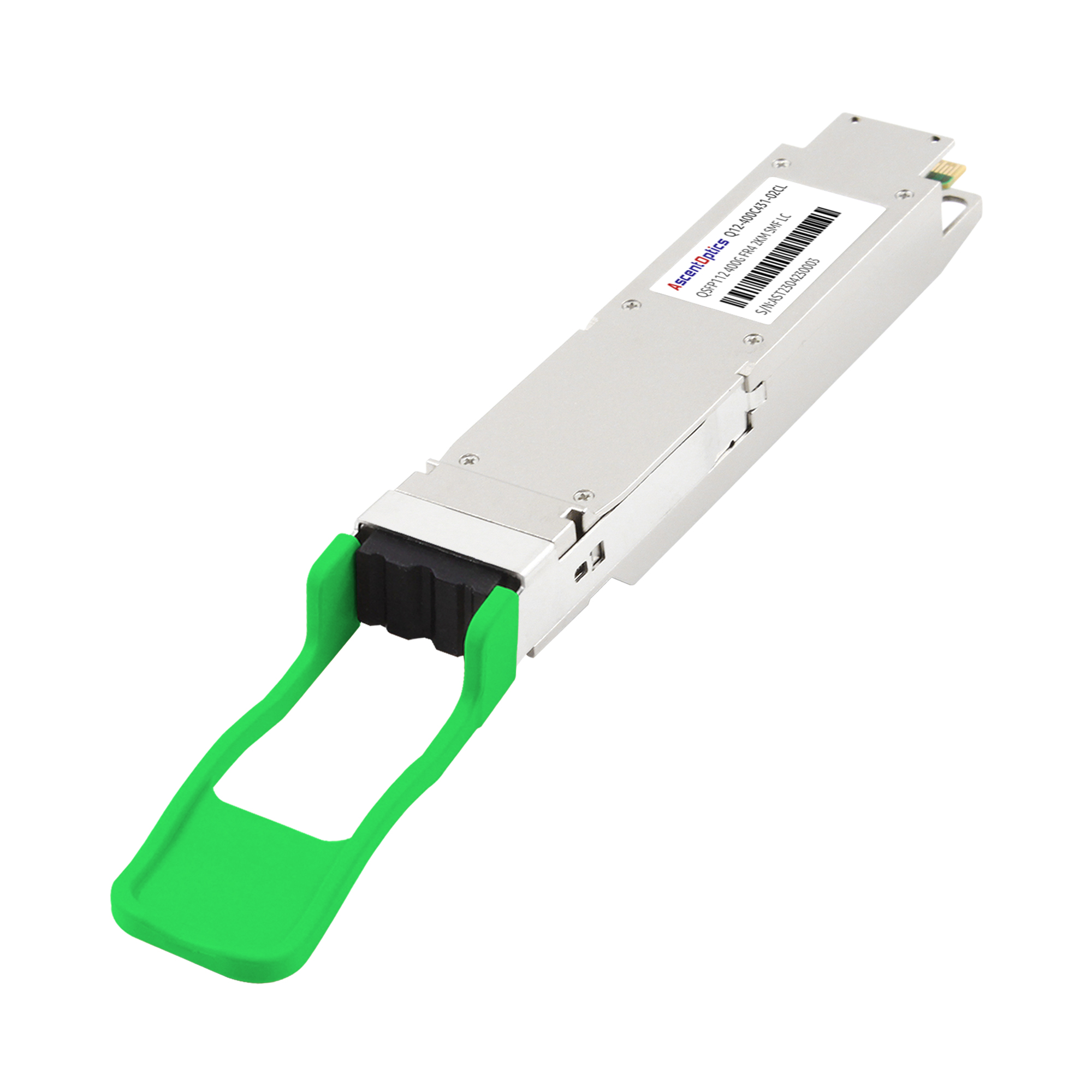The 400G QSFP112 optical transceiver is a high-performance networking module designed to support data rates up to 400 gigabits per second (Gbps). Built on the Quad Small Form-factor Pluggable (QSFP) platform, it leverages 112 Gbps per lane across four lanes, utilizing advanced Pulse Amplitude Modulation 4-Level (PAM4) technology.
This transceiver converts electrical signals into optical signals for transmission over fiber optic cables, ensuring high-speed, reliable data transfer with minimal latency. Its compact design and compatibility with existing QSFP ports make it a versatile solution for modern networking environments.

As data-intensive applications like cloud computing, artificial intelligence (AI), and 5G networks proliferate, the demand for higher bandwidth and lower latency has surged. The 400G QSFP112 transceiver addresses these needs by offering increased data throughput, enhanced power efficiency, and seamless integration with existing infrastructure. It supports the growing requirements of data centers, telecommunications, and high-performance computing (HPC) environments, positioning it as a cornerstone for next-generation network architectures.
The 400G QSFP112 optical module supports data transmission rates of up to 400Gbps, making it ideal for high-bandwidth environments such as large-scale data centers. It uses the QSFP-DD (Quad Small Form-factor Pluggable Double Density) form factor, which is widely compatible with modern network hardware.
Wavelengths vary by fiber type: multimode modules use 850nm VCSEL lasers for short-range connections, while single-mode modules use 1310nm or 1550nm wavelengths for medium to long-distance links. Supported transmission distances include up to 100 meters for SR (MMF), 2 to 500 meters for FR/DR (SMF), and up to 10 kilometers for LR (SMF).
Each module consumes approximately 10–15W of power, balancing performance and energy efficiency. It operates within a temperature range of 0°C to 70°C, suitable for typical data center environments. Depending on the application, the module supports MPO-12/APC or duplex LC connectors, ensuring flexible deployment and fiber compatibility.
These specifications make the QSFP112 a robust and flexible solution for high-performance networks.
High Speed and Low Latency
The 400G QSFP112 optical module supports full-duplex 400Gbps high-speed transmission, with a per-channel rate of up to 112G PAM4. It is well-suited for bandwidth-intensive applications such as AI/ML and high-performance computing (HPC). Some DSP-free models offer ultra-low end-to-end latency of less than 100 nanoseconds, making them ideal for latency-sensitive scenarios like financial trading and real-time data analytics.
Flexible Multimode and Single-Mode Support
The module is available in both multimode and single-mode versions, enabling flexible deployment across different network architectures.
The multimode version (MMF) supports OM3/OM4 fibers and covers transmission distances from 30 to 100 meters (e.g., SR4). It uses VCSEL lasers, offering low cost and low power consumption (≤8W).
The single-mode version (SMF) supports OS2 fibers, with transmission ranges from 500 meters (DR4) up to 40 kilometers (LR4). It adopts EML or silicon photonics technology, keeping power consumption under 14W. This version is ideal for data center interconnects and medium- to long-reach applications.
Advanced Signal Processing
The module integrates a high-performance DSP chip with key functions such as Forward Error Correction (FEC), Clock Data Recovery (CDR), and Equalization (EQ), ensuring improved signal integrity and stable link performance. Some models support the Linear Pluggable Optics (LPO) option, which removes the DSP to reduce power consumption to ≤6W.
In addition, the module adopts optimized PAM4 modulation with a TDECQ of ≤3dB, ensuring a bit error rate (BER) below 1E-12 for reliable high-speed transmission.
Hot-Swappable and Highly Compatible
The QSFP112 module supports hot-swapping and complies with MSA standards, enabling easy on-site deployment and maintenance.
It offers strong electrical interface compatibility, supporting backward compatibility with QSFP56 and QSFP28 modules. When downgraded, it can operate over 200G or 100G links.
Its optical interface also supports flexible expansion, allowing interconnection with 4×100G devices via breakout cables—ideal for distributed systems and multi-rate networking environments.
QSFP112 transceivers support a range of fiber optic cables, including single-mode fiber (SMF) for long-distance applications (up to 10 km at 1310 nm with LC or MPO connectors) and multimode fiber (MMF) for short-reach applications (up to 100 meters at 850 nm with MPO connectors). They are compatible with Dense Wavelength Division Multiplexing (DWDM) systems and optical amplifiers, ensuring versatility across modern and legacy network infrastructures.
Intelligent Management and Diagnostic Capabilities
The module supports the CMIS 5.2 management interface and communicates via the I²C protocol. It enables real-time monitoring of key parameters such as temperature, voltage, optical power, and alarms. It also supports PRBS pattern generation and host/line loopback testing for diagnostics and debugging.
Single-mode QSFP112 transceivers are designed for long-distance transmission, utilizing SMF to support reaches up to 10 km. Variants like the 400G QSFP112 LR4 and FR4 are ideal for telecommunications and inter-data center connectivity, offering high reliability over extended distances.
Multi-mode QSFP112 transceivers, such as the 400G QSFP112 SR4, are optimized for short-reach applications within data centers, supporting distances up to 50–100 meters over MMF. These are cost-effective for high-density, intra-rack connections.
400G QSFP112 optical transceivers are available in multiple types—SR4, DR4, FR4, and LR4—designed to meet a wide range of transmission distance and application requirements in modern data center and AI networks.
SR4 modules are multimode solutions optimized for short-reach applications. They utilize VCSEL lasers and parallel 4×100G PAM4 transmission over OM3 or OM4 multimode fiber, supporting distances up to 100 meters. Featuring MPO-12 interfaces and low power consumption (≤8W), SR4 modules are ideal for high-density rack-to-rack interconnects and AI/GPU clusters.
DR4 modules are based on single-mode fiber and use four parallel lanes over 1310 nm wavelength, supporting up to 500 meters of transmission. They are equipped with EML lasers and MPO-12 connectors, with optional DSP integration. For ultra-low power deployments, DR4 modules can adopt LPO (Linear Pluggable Optics) architecture, reducing power consumption to ≤6W, making them suitable for distributed AI systems and intra-datacenter links.
FR4 modules support transmission distances up to 2 km over duplex single-mode fiber (OS2) using CWDM4 wavelength multiplexing (1270–1330 nm). These modules integrate either EML or silicon photonics technologies and offer high compatibility through standard LC connectors. FR4 is ideal for spine-to-leaf architectures and medium-range data center connections.
LR4 modules are long-reach transceivers designed for distances up to 10 km. They also use CWDM4 wavelength division multiplexing with high-performance EML lasers and duplex LC interfaces. With power consumption typically in the 12–14W range, LR4 modules are well-suited for data center interconnects, campus networks, and metro-edge applications requiring reliable long-distance transmission.
| Module Type |
|

400G QSFP112 DR4 |

400G QSFP112 FR4 |
|
| Fiber Type |
MMF |
SMF | SMF |
SMF |
| Transmission |
100m |
500m | 2km |
10km |
| Wavelength |
850nm |
1310nm | 1310nm |
1310nm |
| Interface |
MPO-12 |
MPO-12 | Duplex LC |
Duplex LC |
| Application |
Intra-rack and short-reach interconnect within data centers |
Short-reach data center interconnect (DCI) | Medium-distance DCI and leaf-spine connections |
Long-distance interconnect across campuses or metro networks |
These four types of QSFP112 modules provide flexible options across short, medium, and long-range applications, supporting high-bandwidth, low-latency, and energy-efficient optical networking.
In data centers, QSFP112 transceivers enable rapid data transfers with low latency, supporting cloud computing, AI, and big data analytics. They facilitate high-bandwidth connections between servers, storage systems, and switches, optimizing data center performance.
QSFP112 transceivers are critical in telecommunications for long-distance, high-speed data transmission. In HPC environments, they support fast data exchanges and high throughput, essential for advanced scientific computations and simulations.
800G-to-two 400G Links: Using straight fiber cables, QSFP112 modules connect to 800G switches or adapters (e.g., NVIDIA ConnectX-7), splitting bandwidth for high-speed interconnects.
800G-to-four 200G Links: Configurable SR4 and DR4 modules with 1:2 splitter cables support four 200G connections, ideal for scalable networks.
400G-to-400G Links: Direct connections between 400G switches using QSFP112 modules ensure seamless, high-speed switch-to-switch communication.
These scenarios highlight the QSFP112’s versatility in modern network architectures.
QSFP112 transceivers are compatible with switches like Cisco Nexus 9000, Arista 7500R3, and Juniper QFX5220, designed for high-performance 400G operations. Always verify compatibility with manufacturer specifications before deployment.
Compatible Cabling Solutions:
Direct Attach Cables (DAC) for QSFP112
Passive DACs: Support short-reach (up to 5 meters) rack-to-rack connections, ideal for cost-effective, high-density setups.
Active DACs: Enhance signal quality for reaches up to 15 meters, suitable for 400G environments.
Breakout DACs: Split a QSFP112 port into multiple SFP+ or SFP28 ports, increasing network flexibility.
Active Optical Cables (AOC) for QSFP112
QSFP112 AOC 100G: Supports up to 100 meters, ideal for HPC and large-scale data centers.
QSFP112-to-QSFP112 AOC: Ensures low-latency, point-to-point connections for long-range communication.
Breakout AOC: Splits a QSFP112 port into multiple lower-speed ports, enhancing scalability.
Breakout Cables for QSFP112 Transceivers
QSFP112 to 4x SFP28: Splits 100G into four 25G ports, supporting legacy 25G infrastructure.
QSFP112 to 4x SFP+: Converts 100G into four 10G ports, ideal for transitioning networks.
QSFP112 to 2x QSFP56: Divides 200G into two 100G ports, enhancing flexibility for advanced setups.
1.Why Choose 400G QSFP112 for Data Centers?
The 400G QSFP112 offers high bandwidth, low latency, and power efficiency, making it ideal for data-intensive applications like AI and cloud computing. Its compatibility with existing QSFP infrastructure ensures cost-effective scalability.
2.What Are the Differences Between QSFP112 and Earlier QSFP Modules?
QSFP112 supports 400 Gbps with 112 Gbps per lane using PAM4, compared to QSFP28 (100 Gbps, NRZ) and QSFP56 (200 Gbps). It offers higher data rates and future-proofing for next-generation networks.
3.How Does QSFP112 Support Future Network Upgrades?
QSFP112’s backward compatibility and support for 112 Gbps lanes pave the way for future 224 Gbps/lane technologies, ensuring scalability without major infrastructure overhauls.
4.What Are the Maximum Reach Capabilities of QSFP112 Transceivers?
QSFP112 transceivers support up to 100 meters on MMF (SR4), 500 meters (DR4), 2 km (FR4), and 10 km (LR4) on SMF, depending on the variant.
5.How Can I Ensure Compatibility with My Network Devices?
Verify compatibility through manufacturer specifications, ensure firmware is updated, and conduct partial testing before full deployment to confirm seamless integration.
6.What Testing is Required for QSFP112 Performance Validation?
Perform spectrum analysis, eye diagram tests, thermal performance tests, and optical power measurements to validate QSFP112 performance and compliance with industry standards.